雅思阅读速度提高的四个基本
雅思g类阅读考满分攻略

雅思g类阅读考满分攻略雅思阅读是雅思考试中一个重要的板块,有些同学却偏偏在这里丢了分,为了帮助大家提高分数,下面小编给大家分享一下雅思g类阅读考满分攻略,希望对大家有所帮助。
雅思阅读提分的三大必备要素要素一:要具备扎实的语言功底词汇量能体现语言功底来,词汇量直接影响的就是考生对于文章的细节的理解,进而影响做题速度和准确率,所以在雅思学习的任何阶段都不可忽略词汇的记忆,读到任何一篇新的文章,都会遇到一些比较关键的生词,大家在平时的学习中要注意积累,随时记下这些比较关键的生词,当然了,并不是要你记下一个就去查一个,而是在记录完一批后再去查,并时常拿出来反复记忆;雅思培训7分班老师认为扎实的语法功底是另外一个影响文章理解的重要因素,雅思阅读中往往有很多从句、复合句,对于这些长难句的理解,万不可忽视的就是对句子的语法分析,熟悉语法规律才能在遇到这些长难句时准确快速的理解文章意思。
要素二:要对考试规律和题型的解题技巧非常了解通常这是通过大量做题总结出来的,当然我们也为了让大家更快地了解并熟练使用这些规律和技巧,总结出了许多做题的经验供大家学习。
当然了,你如果能在做题过程中总结出一些更适合自己使用的技巧那就更好了,因为只有在对题型了解足够充分的情况下,才有可能总结出一些可用的技巧。
要素三:要有目的地拓宽自己的阅读量尤其是一些常考的题材,比如:自然科技类、社会人文类、语言类等。
如果你原本知识面就较广泛,那么在雅思阅读中就更容易去理解文章大意,也更加有助于理解文章的细节信息。
提高雅思阅读成绩要怎么做首先,是如何提高自己英语阅读的基本能力。
而这样的能力又主要分为两个层次:词汇的掌握和读句子的能力。
阅读基本能力的提升,需要至少2个月的时间,通过给学生专业化的方案指导,将课堂上的学习和课堂后的复习相结合,让其在一个合理的时间规划期内去提升自己的基础能力,达到一个最佳的效果。
这也是对于我们老师在教学中要求一直秉持的原则,忌急于求成,囫囵吞枣。
提高雅思阅读速度的五大方法
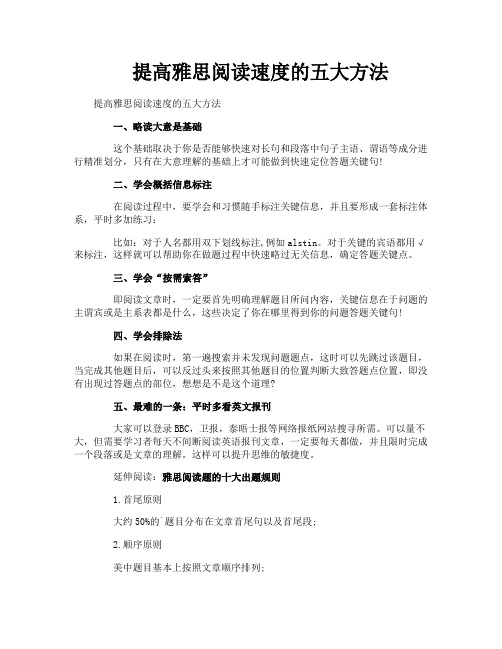
提高雅思阅读速度的五大方法提高雅思阅读速度的五大方法一、略读大意是基础这个基础取决于你是否能够快速对长句和段落中句子主语、谓语等成分进行精准划分,只有在大意理解的基础上才可能做到快速定位答题关键句!二、学会概括信息标注在阅读过程中,要学会和习惯随手标注关键信息,并且要形成一套标注体系,平时多加练习:比如:对于人名都用双下划线标注,例如alstin。
对于关键的宾语都用√来标注,这样就可以帮助你在做题过程中快速略过无关信息,确定答题关键点。
三、学会“按需索答”即阅读文章时,一定要首先明确理解题目所问内容,关键信息在于问题的主谓宾或是主系表都是什么,这些决定了你在哪里得到你的问题答题关键句!四、学会排除法如果在阅读时,第一遍搜索并未发现问题题点,这时可以先跳过该题目,当完成其他题目后,可以反过头来按照其他题目的位置判断大致答题点位置,即没有出现过答题点的部位,想想是不是这个道理?五、最难的一条:平时多看英文报刊大家可以登录BBC,卫报,泰晤士报等网络报纸网站搜寻所需。
可以量不大,但需要学习者每天不间断阅读英语报刊文章,一定要每天都做,并且限时完成一个段落或是文章的理解。
这样可以提升思维的敏捷度。
延伸阅读:雅思阅读题的十大出题规则1.首尾原则大约50%的`题目分布在文章首尾句以及首尾段;2.顺序原则美中题目基本上按照文章顺序排列;3.改写原则出题关键字基本都是对文章内容的改写;4.名词原则出题关键字基本都以名词作为考点;5.数字原则会出现一些带有简单运算最难不超过四则运算的简答题;6.下定义原则破折号,同位语从句,定语从句有可能处提;7.举例原则For example/For instance/Such as等短语前面是考点;8.连词原则表因果、转折、相似、递进以及比较的连词会有题目出现;9.特殊符号,特殊字体原则括号(),引号“”,黑体,斜体,下划线,以及比较罕见的词汇有可能出题;10.图表原则如果文章中有图表则要留心图表部分会出题。
alfred nobel雅思阅读

阅读理解是雅思考试中的重要题型之一,也是考生们普遍认为比较困难的题型之一。
本文将重点讨论阅读理解题型在雅思考试中的重要性,以及如何有效提高阅读理解能力。
1. 阅读理解在雅思考试中的重要性阅读理解是雅思考试中的一个重要题型,占据了整个阅读部分的三分之一甚至更多的篇幅。
在雅思考试中,阅读理解真实地模拟了大学的学术性阅读,因此考生们必须具备良好的阅读理解能力才能在考试中取得理想的成绩。
2. 如何提高阅读理解能力提高阅读理解能力是雅思考生们必须重点关注和努力的方面。
下面将介绍一些提高阅读理解能力的有效方法。
2.1 增加阅读量增加阅读量是提高阅读理解能力的首要方法。
考生们应该多读一些高质量的英文文章,包括新闻、期刊、杂志等,以提高自己对于英文阅读材料的理解能力和应对不同题材文章的能力。
2.2 注意阅读速度和准确性的平衡在雅思考试中,阅读速度和准确性是一个相当重要的问题。
考生们需要在保证阅读速度的情况下,尽量提高阅读准确性。
这需要考生们平时练习时不断提高自己的阅读速度,并培养对文章整体结构的把握能力。
2.3 学会运用预判和定位预判和定位是提高阅读理解能力的重要技巧。
在阅读文章时,考生们应该学会根据文章的标题和第一段落预判整个文章的内容,并在阅读中通过定位关键词来提高阅读效率。
2.4 养成做笔记的习惯做笔记是提高阅读理解能力的重要方法之一。
考生们在平时的练习中,可以养成做笔记、批注文章的习惯,以提高自己对文章细节和逻辑结构的把握能力。
3. 总结阅读理解是雅思考试中的重要题型,对考生们的英文阅读理解能力提出了较高的要求。
考生们应该重视阅读理解题型的练习,并通过增加阅读量、注意阅读速度和准确性的平衡、学会运用预判和定位、养成做笔记的习惯等方法来提高自己的阅读理解能力,以取得理想的成绩。
4. 强化词汇量和语法知识除了阅读量和阅读技巧外,提高阅读理解能力还需要考生们具备丰富的词汇量和良好的语法知识。
在雅思阅读中,经常会遇到一些生僻词汇或复杂句式,如果考生们的词汇量和语法知识不够扎实,就会影响对文章的理解和答题的准确性。
雅思阅读理解的技巧和方法
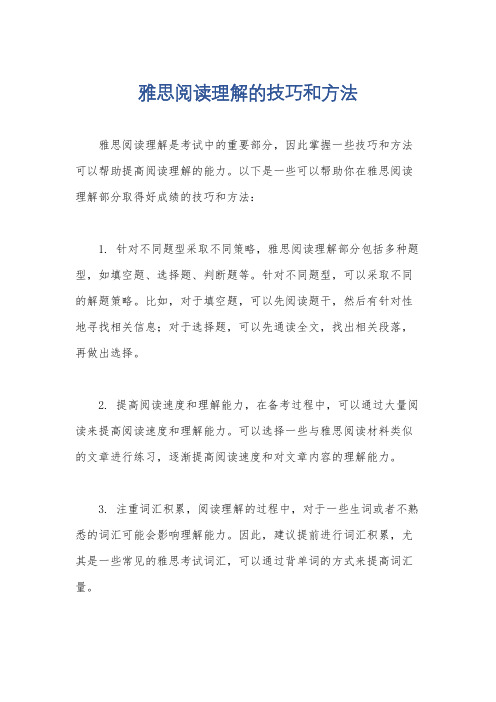
雅思阅读理解的技巧和方法
雅思阅读理解是考试中的重要部分,因此掌握一些技巧和方法可以帮助提高阅读理解的能力。
以下是一些可以帮助你在雅思阅读理解部分取得好成绩的技巧和方法:
1. 针对不同题型采取不同策略,雅思阅读理解部分包括多种题型,如填空题、选择题、判断题等。
针对不同题型,可以采取不同的解题策略。
比如,对于填空题,可以先阅读题干,然后有针对性地寻找相关信息;对于选择题,可以先通读全文,找出相关段落,再做出选择。
2. 提高阅读速度和理解能力,在备考过程中,可以通过大量阅读来提高阅读速度和理解能力。
可以选择一些与雅思阅读材料类似的文章进行练习,逐渐提高阅读速度和对文章内容的理解能力。
3. 注重词汇积累,阅读理解的过程中,对于一些生词或者不熟悉的词汇可能会影响理解能力。
因此,建议提前进行词汇积累,尤其是一些常见的雅思考试词汇,可以通过背单词的方式来提高词汇量。
4. 注意文章结构和逻辑关系,在阅读文章时,要注意文章的结构和逻辑关系,抓住文章的主题和要点,这样有助于更好地理解文章内容,从而更准确地回答问题。
5. 刻意练习和模拟考试,在备考过程中,可以通过大量的刻意练习和模拟考试来提高阅读理解能力。
可以选择一些真题或者模拟题进行练习,逐渐熟悉考试的题型和要求,提高应试能力。
总的来说,雅思阅读理解的技巧和方法包括针对不同题型采取不同策略、提高阅读速度和理解能力、注重词汇积累、注意文章结构和逻辑关系以及进行刻意练习和模拟考试。
通过不断的练习和积累,相信大家可以在雅思阅读理解部分取得更好的成绩。
祝你顺利通过雅思考试!。
雅思阅读做题技巧有哪些
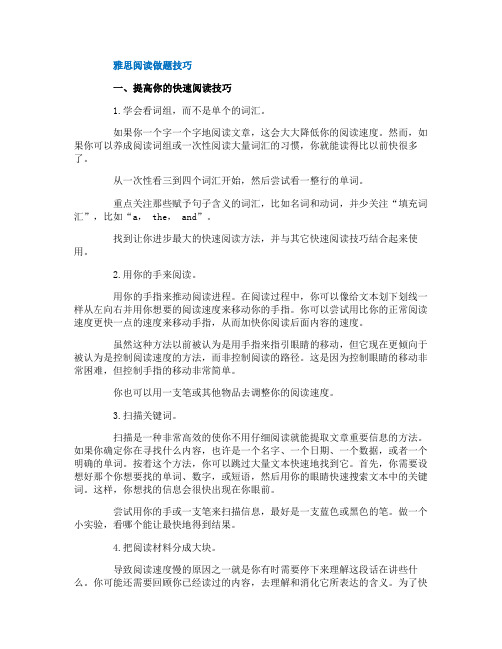
雅思阅读做题技巧一、提高你的快速阅读技巧1.学会看词组,而不是单个的词汇。
如果你一个字一个字地阅读文章,这会大大降低你的阅读速度。
然而,如果你可以养成阅读词组或一次性阅读大量词汇的习惯,你就能读得比以前快很多了。
从一次性看三到四个词汇开始,然后尝试看一整行的单词。
重点关注那些赋予句子含义的词汇,比如名词和动词,并少关注“填充词汇”,比如“a, the,and”。
找到让你进步最大的快速阅读方法,并与其它快速阅读技巧结合起来使用。
2.用你的手来阅读。
用你的手指来推动阅读进程。
在阅读过程中,你可以像给文本划下划线一样从左向右并用你想要的阅读速度来移动你的手指。
你可以尝试用比你的正常阅读速度更快一点的速度来移动手指,从而加快你阅读后面内容的速度。
虽然这种方法以前被认为是用手指来指引眼睛的移动,但它现在更倾向于被认为是控制阅读速度的方法,而非控制阅读的路径。
这是因为控制眼睛的移动非常困难,但控制手指的移动非常简单。
你也可以用一支笔或其他物品去调整你的阅读速度。
3.扫描关键词。
扫描是一种非常高效的使你不用仔细阅读就能提取文章重要信息的方法。
如果你确定你在寻找什么内容,也许是一个名字、一个日期、一个数据,或者一个明确的单词。
按着这个方法,你可以跳过大量文本快速地找到它。
首先,你需要设想好那个你想要找的单词、数字,或短语,然后用你的眼睛快速搜索文本中的关键词。
这样,你想找的信息会很快出现在你眼前。
尝试用你的手或一支笔来扫描信息,最好是一支蓝色或黑色的笔。
做一个小实验,看哪个能让最快地得到结果。
4.把阅读材料分成大块。
导致阅读速度慢的原因之一就是你有时需要停下来理解这段话在讲些什么。
你可能还需要回顾你已经读过的内容,去理解和消化它所表达的含义。
为了快速阅读,你可以尝试只在每一个阅读阶段结束时停下来,或者在每个阅读部分或章节结束的时候停下来思考。
在每个快速阅读阶段结束后确认自己是否理解阅读内容,你可以写下这段阅读的关键词,用几句话总结这段阅读材料,或者尝试向别人解释这段阅读内容。
雅思阅读定位技巧
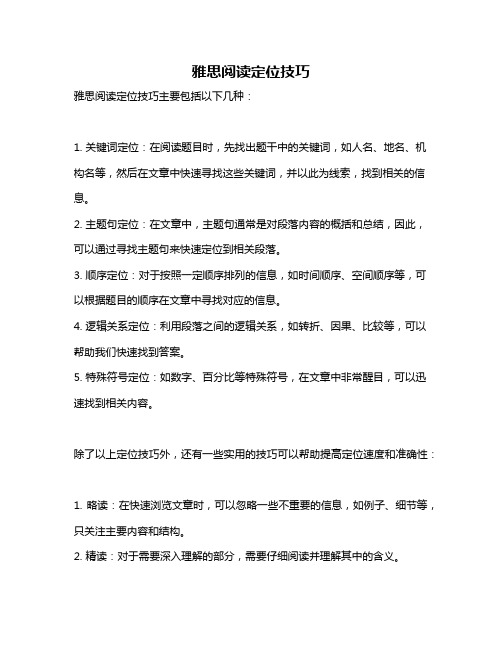
雅思阅读定位技巧
雅思阅读定位技巧主要包括以下几种:
1. 关键词定位:在阅读题目时,先找出题干中的关键词,如人名、地名、机构名等,然后在文章中快速寻找这些关键词,并以此为线索,找到相关的信息。
2. 主题句定位:在文章中,主题句通常是对段落内容的概括和总结,因此,可以通过寻找主题句来快速定位到相关段落。
3. 顺序定位:对于按照一定顺序排列的信息,如时间顺序、空间顺序等,可以根据题目的顺序在文章中寻找对应的信息。
4. 逻辑关系定位:利用段落之间的逻辑关系,如转折、因果、比较等,可以帮助我们快速找到答案。
5. 特殊符号定位:如数字、百分比等特殊符号,在文章中非常醒目,可以迅速找到相关内容。
除了以上定位技巧外,还有一些实用的技巧可以帮助提高定位速度和准确性:
1. 略读:在快速浏览文章时,可以忽略一些不重要的信息,如例子、细节等,只关注主要内容和结构。
2. 精读:对于需要深入理解的部分,需要仔细阅读并理解其中的含义。
3. 划重点:在阅读过程中,可以将重要的信息、关键词或主题句划线或标记,方便后续查找。
4. 预测答案:根据题目和定位的信息,可以预测可能的答案并注意相关内容。
5. 检查答案:在完成题目后,应仔细检查答案是否符合题目的要求和定位的信息。
总之,定位技巧在雅思阅读中非常重要,需要不断练习和积累经验。
通过掌握这些技巧,可以提高阅读速度和准确性,为取得好成绩打下基础。
冲高分必备,雅思阅读超实用技巧!
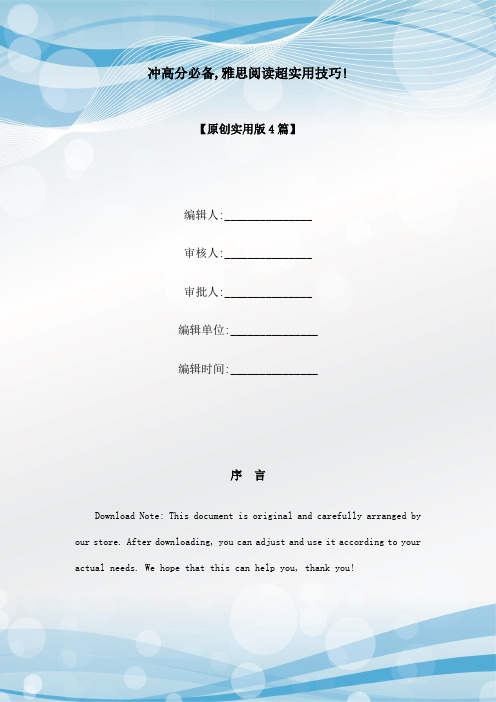
【原创实用版4篇】编辑人:_______________审核人:_______________审批人:_______________编辑单位:_______________编辑时间:_______________序言Download Note: This document is original and carefully arranged by our store. After downloading, you can adjust and use it according to your actual needs. We hope that this can help you, thank you!(4篇)《冲高分必备,雅思阅读超实用技巧!》篇1雅思阅读是备考中的重要部分,以下是一些实用的技巧:1. 熟悉考试格式和题型:了解雅思阅读考试的格式和题型,包括文章类型、题目类型和答案类型等,可以帮助你更好地应对考试。
2. 培养以获取信息为目的的阅读习惯:雅思阅读是一个语言知识和能力为工具达到获取有用信息的过程,所以要注重培养以获取信息为目的的阅读习惯。
3. 提高阅读速度和理解能力:雅思阅读要求在一个小时能阅读三篇文章,完成四十道题目,对阅读速度和对文章的理解能力是有着较高要求的,因此要平时多练习,提高阅读速度和理解能力。
4. 做题技巧:对于不同类型的题目,要有相应的做题技巧,如填空题要认真判断答案词的词性和各种特征,选择题要注意题目中的关键词和句子结构等。
5. 练习同替整理:同替整理是指将同一类型的题目进行分类整理,从而更好地理解和记忆题目的解题方法。
6. 多做真题:多做雅思阅读真题,可以更好地了解考试的难度和题型,提高答题效率和准确率。
《冲高分必备,雅思阅读超实用技巧!》篇2雅思阅读是备考中的重要部分,以下是一些实用的技巧:1. 熟悉考试格式和题型:了解雅思阅读考试的格式和题型,包括文章类型、题目类型和答案类型等,可以帮助你更好地应对考试。
雅思阅读之技巧归纳
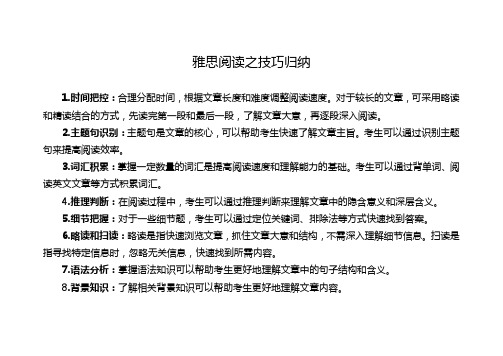
雅思阅读之技巧归纳
1.时间把控:合理分配时间,根据文章长度和难度调整阅读速度。
对于较长的文章,可采用略读和精读结合的方式,先读完第一段和最后一段,了解文章大意,再逐段深入阅读。
2.主题句识别:主题句是文章的核心,可以帮助考生快速了解文章主旨。
考生可以通过识别主题句来提高阅读效率。
3.词汇积累:掌握一定数量的词汇是提高阅读速度和理解能力的基础。
考生可以通过背单词、阅读英文文章等方式积累词汇。
4.推理判断:在阅读过程中,考生可以通过推理判断来理解文章中的隐含意义和深层含义。
5.细节把握:对于一些细节题,考生可以通过定位关键词、排除法等方式快速找到答案。
6.略读和扫读:略读是指快速浏览文章,抓住文章大意和结构,不需深入理解细节信息。
扫读是指寻找特定信息时,忽略无关信息,快速找到所需内容。
7.语法分析:掌握语法知识可以帮助考生更好地理解文章中的句子结构和含义。
8.背景知识:了解相关背景知识可以帮助考生更好地理解文章内容。
skimming for the gist的阅读四步法
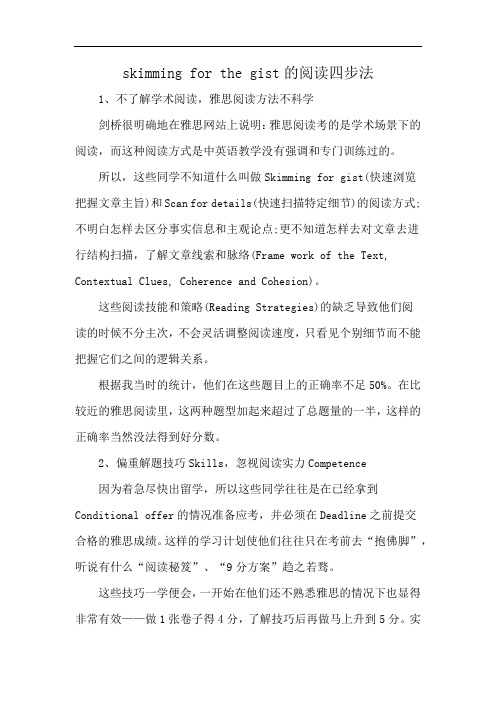
skimming for the gist的阅读四步法1、不了解学术阅读,雅思阅读方法不科学剑桥很明确地在雅思网站上说明:雅思阅读考的是学术场景下的阅读,而这种阅读方式是中英语教学没有强调和专门训练过的。
所以,这些同学不知道什么叫做Skimming for gist(快速浏览把握文章主旨)和Scan for details(快速扫描特定细节)的阅读方式;不明白怎样去区分事实信息和主观论点;更不知道怎样去对文章去进行结构扫描,了解文章线索和脉络(Frame work of the Text, Contextual Clues, Coherence and Cohesion)。
这些阅读技能和策略(Reading Strategies)的缺乏导致他们阅读的时候不分主次,不会灵活调整阅读速度,只看见个别细节而不能把握它们之间的逻辑关系。
根据我当时的统计,他们在这些题目上的正确率不足50%。
在比较近的雅思阅读里,这两种题型加起来超过了总题量的一半,这样的正确率当然没法得到好分数。
2、偏重解题技巧Skills,忽视阅读实力Competence因为着急尽快出留学,所以这些同学往往是在已经拿到Conditional offer的情况准备应考,并必须在Deadline之前提交合格的雅思成绩。
这样的学习计划使他们往往只在考前去“抱佛脚”,听说有什么“阅读秘笈”、“9分方案”趋之若骛。
这些技巧一学便会,一开始在他们还不熟悉雅思的情况下也显得非常有效——做1张卷子得4分,了解技巧后再做马上升到5分。
实际上并不是这些阅读技巧有多少神奇之处,只是由陌生到熟悉以后自然的提高,然而同学们还是对此深信不疑。
但是雅思阅读毕竟是现在所有出英语考中阅读单项较难的一个,文章较长、题型较多、难度较大,对于阅读技能的考察非常各方面深入。
迷信解题技巧而忽视实力的后果像Castle in the air,吹得越神的技巧也让人摔得越惨。
技巧有局限,好成绩靠实力。
雅思阅读howshouldreading

雅思阅读howshouldreading【原创版】目录1.雅思阅读的重要性2.如何提高雅思阅读能力3.阅读练习的方法和技巧4.备考建议和注意事项正文一、雅思阅读的重要性雅思考试作为全球范围内最受欢迎的英语能力测试之一,其阅读部分对于考生的综合英语能力有着极高的要求。
阅读理解能力的提高,不仅可以帮助考生在雅思考试中取得好成绩,同时也有助于提升日常生活和工作中的英语应用能力。
因此,在备考雅思过程中,提高阅读能力显得尤为重要。
二、如何提高雅思阅读能力1.扩大词汇量:词汇是阅读理解的基础。
要想在雅思阅读中取得好成绩,首先需要积累一定的词汇量。
可以通过学习词汇书籍、词汇卡片、在线词汇学习工具等方式进行学习。
2.提高阅读速度:在雅思阅读考试中,时间是有限的。
因此,提高阅读速度是关键。
可以通过大量阅读英语文章,逐渐提高阅读速度。
同时,要学会跳读、略读等阅读技巧,有选择性地获取信息。
3.培养阅读习惯:养成良好的阅读习惯,有助于提高阅读理解能力。
每天抽出一定时间进行英语阅读,既可以保持英语语感,也可以积累知识。
4.学习阅读策略:学习一些阅读策略和技巧,可以帮助考生更好地理解文章。
例如,学会通过标题、小标题、关键词等快速把握文章主题,通过判断题、填空题等题型的特点,提前预测文章内容。
三、阅读练习的方法和技巧1.多读:多读英语文章,不仅可以扩大词汇量,还可以培养阅读习惯。
可以选择感兴趣的领域,如新闻、科技、文化等,进行广泛阅读。
2.精读:选择一些高质量的文章进行精读,深入理解文章结构、语法、词汇等方面。
可以逐句阅读,分析句子结构,学习生词和短语。
3.练习题型:针对雅思阅读考试的题型,进行专项练习。
可以通过模拟题、真题等形式,熟练掌握各种题型的解题技巧。
4.计时练习:为了适应雅思阅读考试的节奏,可以进行计时练习。
在规定时间内完成阅读任务,逐步提高阅读速度和理解能力。
四、备考建议和注意事项1.制定合理的学习计划:根据自己的实际情况,制定合适的学习计划,合理安排时间,保证学习效果。
怎样提高英语阅读速度

怎样提高英语阅读速度(总9页) --本页仅作为文档封面,使用时请直接删除即可----内页可以根据需求调整合适字体及大小--【托福.SAT.雅思.】通用提高阅读速度【其实看完这你的速度已经提高了】TIPS FOR INCREASING READING SPEEDAs our eyes move across the page they make a series of jerky movements. Whenever they come to rest on a word that is called a fixation. Most people fixate once on each word across a line of print.In order to make our speed increase we must take in more words with each fixation, rather than make our eyes move faster.1. Try to avoid focusing on every word, but rather look at groups of2 to3 words. For instance, this sentence could be grouped in this manner:for instance / this sentence / could be grouped / in this manner2. Work on vocabulary improvement. Familiarize yourself with newwords so you don't get stuck on them when you read them again.3. If you find yourself moving your lips when reading, force yourselfto read faster by following (1.) above so that you can no longer move your lips.4. Read more! 15 minutes a day of reading an average size novelequals 18 books a year at an average reading speed!your purpose before reading. If you only need main ideas, then allow yourself to skim the material. Don't feel you must read very word.a few minutes a day reading at a faster than comfortable rate (about2 to3 times faster than your normal speed). Use your hand or anindex card to guide your eyes down the page. Then time yourselfreading a few pages at your normal speed. You'll find that often your normal reading speed will increase after your skimming practice.7. If you have poor concentration when reading, practice reading for only 5 - 10 minutes at a time and gradually increase this time.are several books on increasing reading speed available in most bookstores. If you are serious about increasing your rate you maywant to work systematically through one of these booksSUGGESTIONS FOR IMPROVING READING SPEEDImprovement of Reading RateIt is safe to say that almost anyone can double his speed of reading while maintaining equal or even higher comprehension. In other words, anyone can improve the speed with which he gets what he wants from his reading.The average college student reads between 250 and 350 words per minute on fiction and non-technical materials. A "good" reading speed is around 500 to 700 words per minute, but some people can read a thousand words per minute or even faster on these materials. What makes the differenceThere are three main factors involved in improving reading speed: (1) the desire to improve, (2) the willingness to try new techniques and (3) the motivation to practice.Learning to read rapidly and well presupposes that you have the necessary vocabulary and comprehension skills. When you have advanced on the reading comprehension materials to a level at which you can understand college-level materials, you will be ready to speed reading practice in earnest.The Role of Speed in the Reading ProcessUnderstanding the role of speed in the reading process is essential. Research has shown a close relation between speed and understanding. For example, in checking progress charts of thousands of individuals taking reading training, it has been found in most cases that an increase in rate has been paralleled by an increase in comprehension, and that where rate has gone down, comprehension has also decreased. Although there is at present little statistical evidence, it seems that plodding word-by-word analysis (or word reading) inhibits understanding. There is some reason to believe that the factors producing slow reading are also involved in lowered comprehension. Most adults are able to increase their rate of reading considerably and rather quickly without lowering comprehension. These same individuals seldom show an increase in comprehension when they reduce their rate. In other cases, comprehension is actually better at higher rates of speed. Such results, of course, are heavily dependent upon the method used to gain the increased rate. Simply reading morerapidly without actual improvement in basic reading habits usually results in lowered comprehension.Factors that Reduce Reading RateSome of the facts which reduce reading rate: (a) limited perceptual span ., word-by-word reading; (b) slow perceptual reaction time, ., slowness of recognition and response to the material; (c) vocalization, including the need to vocalize in order to achieve comprehension; (d) faulty eye movements, including inaccuracy in placement of the page, in return sweep, in rhythm and regularity of movement, etc.; (e) regression, both habitual and as associated with habits of concentration; (f) faulty habits of attention and concentration, beginning with simple inattention during the reading act and faulty processes of retention; (g) lack of practice in reading, due simply to the fact that the person has read very little and has limited reading interests so that very little reading is practiced in the daily or weekly schedule; (h) fear of losing comprehension, causing the person to suppress his rate deliberatelyin the firm belief that comprehension is improved if he spends more time on the individual words; (i) habitual slow reading, in which the person cannot read faster because he has always read slowly, (j) poor evaluation of which aspects are important and which are unimportant; and (k) the effort to remember everything rather than to remember selectively.Since these conditions act also to reduce comprehension increasing the reading rate through eliminating them is likely to result in increased comprehension as well. This is an entirely different matter from simply speeding up the rate of reading without reference to the conditions responsible for the slow rate. In fact, simply speeding the rate especially through forced acceleration, may actually result, and often does, in making the real reading problem more severe. In addition, forced acceleration may even destroy confidence in ability to read. The obvious solution, then is to increase rate as a part of a total improvement of the whole reading process. This is a function of special training programs in reading.Basic Conditions for Increased Reading RateA well planned program prepares for maximum increase in rate by establishing the necessary conditions. Four basic conditions include:1. Have your eyes checked. Before embarking on a speed reading program, make sure that any correctable eye defects you may have aretaken care of by checking with your eye doctor. Often, very slow reading is related to uncorrected eye defects.2. Eliminate the habit of pronouncing words as you read. If you sound out words in your throat or whisper them, you can read slightly only as fast as you can read aloud. You should be able to read most materials at least two or three times faster silently than orally. If you are aware of sounding or "hearing" words as you read, try to concentrate on key words and meaningful ideas as you force yourself to read faster.3. Avoid regressing (rereading). The average student reading at 250 words per minute regresses or rereads about 20 times per page. Rereading words and phrases is a habit which will slow your reading speed down to a snail's pace. Usually, it is unnecessary to reread words, for the ideas you want are explained and elaborated more fully in later contexts. Furthermore, the slowest reader usually regresses most frequently. Because he reads slowly, his mind has time to wander and his rereading reflects both his inability to concentrate and his lack of confidence in his comprehension skills.4. Develop a wider eye-span. This will help you read more than one word at a glance. Since written material is less meaningful if read word by word, this will help you learn to read by phrases or thought units.Rate AdjustmentPoor results are inevitable if the reader attempts to use the same rate indiscriminately for a-1 types of material and for all reading purposes. He must learn to adjust his rate to his purpose in reading and to the difficulty of the material he is reading. This ranges from a maximum rate on easy, familiar, interesting material or in reading to gather information on a particular point, to minimal rate on material which is unfamiliar in content and language structure or which must be thoroughly digested. The effective reader adjusts his rate; the ineffective reader uses the same rate for all types of material.Rate adjustment may be overall adjustment to the article as a whole, or internal adjustment within the article. Overall adjustment establishes the basic rate at which the total article is read; internal adjustment involves the necessary variations in rate for each varied part of the material. As an analogy, you plan to take a 100-mile mountain trip. Since this will be a relatively hard drivewith hills, curves, and a mountain pass, you decide to take three hours for the total trip, averaging about 35 miles an hour. This is your overall rate adjustment. However, in actual driving you may slow down to no more than 15 miles per hour on some curves and hills,while speeding up to 50 miles per hour or more on relatively straight and level sections. This is your internal rate adjustment. There isno set rate, therefore, which the good reader follows inflexibly in reading a particular selection, even though he has set himself an overall rate for the total job.Overall rate adjustment should be based on your reading plan, your reading purpose, and the nature and difficulty of the material. The reading plan itself should specify the general rate to be used. Thisis based on the total "size up". It may be helpful to consider examples of how purpose can act to help determine the rate to be used. To understand information, skim or scan at a rapid rate. To determine value of material or to read for enjoyment, read rapidly or slowly according to you feeling. To read analytically, read at a moderate pace to permit interrelating ideas. The nature and difficulty of the material requires an adjustment in rate in conformity with yourability to handle that type of material. Obviously, level ofdifficulty is highly relative to the particular reader. WhileEinstein's theories may be extremely difficult to most laymen, they may be very simple and clear to a professor of physics. Hence, the layman and the physics professor must make a different rateadjustment in reading the same material. Generally, difficultmaterial will entail a slower rate; simpler material will permit a faster rate.Internal rate adjustment involves selecting differing rates for parts of a given article. In general, decrease speed when you find the following (1) unfamiliar terminology not clear in context. Try to understand it in context at that point; otherwise, read on and return to it later; (2) difficult sentence and paragraph structure; slow down enough to enable you to untangle them and get accurate contextfor the passage; (3) unfamiliar or abstract concepts. Look for applications or examples of you own as well as studying those of the writer. Take enough time to get them clearly in mind; (4) detailed, technical material. This includes complicated directions, statementsof difficult principles, materials on which you have scant background;(5) material on which you want detailed retention. In general, increase speed when you meet the following: (a) simple material with few ideas which are new to you; move rapidly over the familiar ones; spend most of your time on the unfamiliar ideas; (b) unnecessary examples and illustrations. Since these are included to clarify ideas,move over them rapidly when they are not needed; (c) detailed explanation and idea elaboration which you do not need, (d) broad, generalized ideas and ideas which are restatements of previous ones. These can be readily grasped, even with scan techniques.In keeping your reading attack flexible, adjust your rate sensitivity from article to article. It is equally important to adjust you rate within a given article. Practice these techniques until a flexible reading rate becomes second nature to you.SummaryIn summary, evidence has been cited which seems to indicate a needfor and value of a rapid rate of reading, while at the same time indicating the dangers of speed in reading, as such. We have attempted to point out the relationship between rate of reading and extent of comprehension, as well as the necessity for adjustment of reading rate, along with whole reading attack, to the type of material and the purposes of the reader. Finally, the factors which reduce rate were surveyed as a basis for pointing out that increasein rate should come in conjunction with the elimination of these retarding aspects of the reading process and as a part of an overall reading training program where increase in rate is carefully prepared for in the training sequence.Adapted by permission of RSSL, University of Maryland.TIPS FOR IMPROVING YOUR READING SPEEDThe purpose of this section is to teach you how to increase you reading speed. Shortly we will be adding a section for reading BETTER as opposed to FASTER.We all have a capacity for reading much faster than we typically do. Our reading speed changes as we go through life. When we are in high school, we go through about two hundred words a minute. We get to college and, because we have to read faster due to more time constraints and a much greater amount to read, we read faster. Most people in college average about 400 words per minute. Then we get out of college, and now we don't have to read so fast. There are no longer time constraints, and we can read slow and easy. We find ourselves dropping back down to about 200 words per minute.Think of reading like you do a muscle, the more you read, the better you get at it, the faster you're going to read. And we have a great capacity for reading faster. We aren't even scraping the surface of how fast we can read. You see, we have 1,000,000,000,000 brain cells. In fact, the inner connections, the synapses, in our mind arevirtually infinite. It has been estimated by a Russian scientist that the number of synapses we have would be one followed by 10 million kilometers of zeros. Our physical capacity for reading is beyond our comprehension. Our visual unit has the capability to take in a full page of text in 1/20 of a second. If we could turn the pages fast enough, our brain could process it faster than our eyes can see it.If we could turn those pages fast enough, our eyes have the capacity to read a standard book in six to twenty-five seconds depending on the length of the book. We could take in the entire Encyclopedia Britannica in one hour. So reading 700 - 1,000 words a minute is easily within our reach.The key to improving our speed is to SIGHT READ, and that's what we are going to show you how to do. We are going to start being pure sight readers. Obstacles get in our way, however. What do we mean by obstacles Well, these are things that impede us from reading faster.REGRESSIONS are the most wasteful. Regressions are going back over words. You can call it back-skipping if you want. You go back over words you previously read. People do it for two reasons. Initially we read it to clarify the meaning of what we're reading. We want to be sure of the words we read as we go along. In our early years in school, when we were first taught - incorrectly - to "read slowly and carefully," it became easy to go back over words.Well, this not only slows you down, it causes you comprehension problems. For instance, lets say you have a sentence, "The man jumped over the log." Well, if you back-skip, you read that passage like this: "The man jumped," "the man . . . jumped. . . over the log," "jumped over the log." So, what your brain is processing, "The man jumped," "the man jumped," "jumped over the log." Our brain is usedto processing our flaws, so the brain thinks, "OK, I know what this clown is saying, "The man jumped over the log." But this takes timeto sort out. And it's confusing. Think how much easier it would be if you simply took the sentence in one sight, "The man jumped over the log." There's no confusion there. Then you move on to the next phrase. Regressing or back-skipping is the most harmful thing we do to slow our reading speed.Our second obstacle is that we have BAD HABITS that we pick up. Bad habits manifest themselves in a number of ways. For one, you've got people who have MOTOR habits as they read. These are the people who are tapping a pencil when they read, tapping a foot when they read, moving a book, flicking their hand, etc. If they're sitting next to you, they drive you nuts. But they are the people who have to be moving while they read.Some may even move their lips. If they do that, they're kind ofedging over into another bad habit where we find AUDITORY readers. This is the bad habit that we have that is the hardest to drop. Auditory reading is difficult to beat because we are used to reading and hearing the words in our minds. Some people even go so far as to mumble the words. You can see their lips moving sometimes, or you can even hear a guttural growl as they go through the words.The other obstacle are the FIXATIONS. Fixations are the actual stops or pauses between eye-spans when the eye is moving to its nextfixation point. We can't see while the eye moves so you do need the fixation points to see. The problem is, most people fixate word by word by word. They stop their eyes on each separate word. Thefixations slow you down because you are stopping on each word.The problem that comes up here is this that, like the other obstacles, it impedes concentration and comprehension as well. The paradox with reading slowly is that it really hurts your concentration.Research has shown a close relation between speed and understanding.In checking progress charts of thousands of individuals takingreading training, its been found that in the vast majority of cases, that an increase in speed reading rate has also been paralleled by an increase in comprehension. The plodding word by word analyzation actually reduces comprehension.In this day and age, our brains are used to constant stimulation. Television, radio, even people talking to you, provide constant stimulation. So when we are reading along slowly and carefully, it's kind of like watching a movie and we encounter a slow motion scene. The slow motion scene is kind of interesting at first because the movie has been moving along at a rapid clip and now we have a changeof pace. We've got the slow motion scene of the guy getting shot or the couple running across to each other across a field, and the mind initially says, "Oh, this is cool. This is something different."After a while we get a little impatient and we're ready for the guy who got shot to hit the ground, or the couple who are running across the field to finally get to each other. We start thinking about other things..weve lost our focus on the movie.The brain does the same thing when we read. The brain is getting all the stimulation it normally gets, then we hit this patch where you're reading slowly. And boom, the brain says, "I don't like this. I think I'm going to start thinking about something else." And the reader starts thinking about the date they had Saturday night or the date they hope to have Saturday night. And therefore, you've got another impediment to comprehending the reading correctly.OK, what do we doWell, there are several things we are going to do to increase reading speed. First of all. we are going to increase the EYE SPAN. Eye spanis the number of words that you take in as you look at the words. In other words, if my eye span is just one word, I am going to move from word to word to word. If my eye span is two words, I am going to move along twice as fast. If my eye span is three words, three times as fast. If I am moving along in phrases, I'm flying along pretty good.That's where you increase the rate of eye span. You also want tolearn to work in THOUGHT UNITS. Thought units help you move faster. This is where you group the words according to context. For instance, lets say you have, "He said something." It's easy to put that in a phrase, then you move to the next phrase. If I had this sentence,"It's safe to say that almost anyone can double his speed of reading while maintaining equal or higher comprehension." If I want to read that in phrases, "It's safe to say that almost anyone.......candouble his speed........of reading while maintaining.......equal or even higher comprehension." You move much faster that way.So, we are going to increase the number of words we see and we are going to group them according to context. One of the key things that we are also going to work on is RETURN EYE SWEEP. When you get to the end of the sentence or the end of the line on the written page, if your eye meanders back to the other side, you have a chance to pickup words. If you're picking up words and you're sight reading, that can be confusing. So you want to dramatically, quickly, forcefully,go from the end of one line to the beginning of the next one. Using a fingertip or pen as a pointer is a great way to quickly and directly to the next line.The other thing that helps us increase our speed is CONFIGU R ATION. As you read faster and faster, you've got to learn to rely on your increased recognition of how words are configured, how they look, as you do it. In other words, "material" looks different than "response". "Recognition" looks different than "perceptual". The words havevisual configurations. As you learn to read faster and faster youlearn to pick up on the configurations and, as you do better and better, your skills at this improve with practice.So, we are going to have no REGRESSIONS, no VOCALIZATIONS, and increased EYE SPAN. That's the way to true sight reading. How do wedo thisFirst, we avoid the problem areas. We avoid the limited eye-span by expanding the number of words that we take in. We get rid of regressions and we get rid of the return eye sweep problem by using a pointer. You can use a pen, a pencil, even your finger. That givesyou a point of focus for your eyes. It helps you focus on the page, and you move faster because you can dictate how fast you are moving across the page. Your eye will follow your finger, or pen, or pencil.Absolutely stay away from the vocalizations. You have got to be asight reader. You have got to read fast enough so that you don't have time to hear the words. This way you are comprehending simply with your eyes.You also need to keep in mind that you don't always read at the same speed. If you've got a car that will go 120 miles per hour, you'renot going to drive that care 120 miles per hour in a shopping center. You'd get killed and get a heck of a ticket. But you may, on a highway when you are passing a car, get it up to a high speed. When you are in that shopping center, you are going to be driving about 30 miles per hour.It's the same thing with reading. This is specifically addressed in our Better Reading section. But you must learn that you speed read in certain areas and there are other areas that may be particularly dense, that may have something that's particularly confusing to you, when you will need to slow down and read in shorter phrases, smaller groupings of words so that you can comprehend it clearly. It may be a particularly dense passage where each word has great deal of meaning. It may be even an unusual or specific word.Let's look at what we've got to do to practice it. The big step here is to simply read faster. It sounds like such a simple statement, it almost sounds stupid. But it's what you have to do. You have to focus on "I'm going to read faster," first.Comprehension comes later. Practice reading without a great concern for comprehension. In clinical terms, we call this the comprehension lag. It takes the mind as many as ten to fifteen days to adapt to the new reading rate.You are going to go through periods, practice periods, you can't use on school books, but it's a practice period where you are simply adapting to reading that much faster. Comprehension lags for a while but when it catches up it makes a stunning difference.A good place to practice this is magazines or newspapers. They have narrow columns that almost make a perfect thought unit. You can almost go straight down the column, taking that finger and puttting it in the middle of the column and moving it straight down the page. You will be stunned how soon you will be able to improve and comprehend what you are reading that way. You find that it's quick. It's easy reading.WEEKLY PLAN TO IMPROVE READING SPEEDRead 2 chptrs ---------------------------- 3 Min -------------------------2 Minno regressions -----------------------no vocalization ---------------Maximum Speed。
雅思阅读howshouldreading
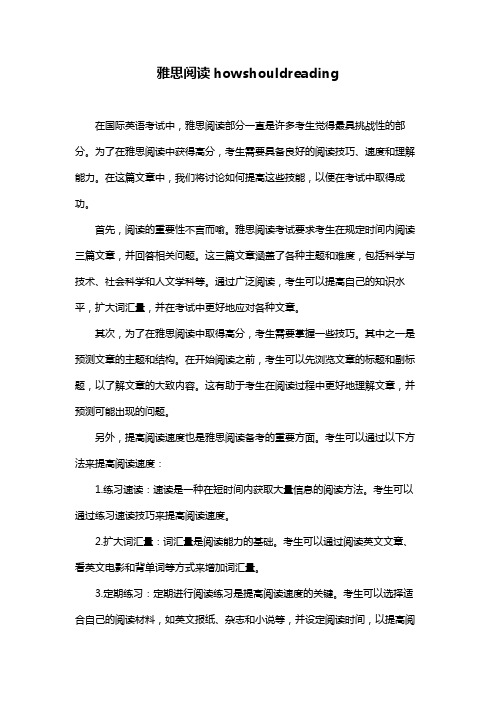
雅思阅读howshouldreading在国际英语考试中,雅思阅读部分一直是许多考生觉得最具挑战性的部分。
为了在雅思阅读中获得高分,考生需要具备良好的阅读技巧、速度和理解能力。
在这篇文章中,我们将讨论如何提高这些技能,以便在考试中取得成功。
首先,阅读的重要性不言而喻。
雅思阅读考试要求考生在规定时间内阅读三篇文章,并回答相关问题。
这三篇文章涵盖了各种主题和难度,包括科学与技术、社会科学和人文学科等。
通过广泛阅读,考生可以提高自己的知识水平,扩大词汇量,并在考试中更好地应对各种文章。
其次,为了在雅思阅读中取得高分,考生需要掌握一些技巧。
其中之一是预测文章的主题和结构。
在开始阅读之前,考生可以先浏览文章的标题和副标题,以了解文章的大致内容。
这有助于考生在阅读过程中更好地理解文章,并预测可能出现的问题。
另外,提高阅读速度也是雅思阅读备考的重要方面。
考生可以通过以下方法来提高阅读速度:1.练习速读:速读是一种在短时间内获取大量信息的阅读方法。
考生可以通过练习速读技巧来提高阅读速度。
2.扩大词汇量:词汇量是阅读能力的基础。
考生可以通过阅读英文文章、看英文电影和背单词等方式来增加词汇量。
3.定期练习:定期进行阅读练习是提高阅读速度的关键。
考生可以选择适合自己的阅读材料,如英文报纸、杂志和小说等,并设定阅读时间,以提高阅读速度。
4.提高阅读理解能力:阅读理解是雅思阅读考试的核心。
为了提高理解能力,考生可以:1.多做阅读练习,以熟悉不同类型的文章和题型。
2.学习并运用一些阅读策略,如扫描、略读和寻读等。
3.在阅读过程中,注意捕捉文章的主旨和细节。
4.结合上下文推测生词的含义。
最后,考生可以在备考过程中进行大量的练习,以提高自己的阅读能力。
一些建议包括:1.制定合理的备考计划,确保每天都有时间进行阅读练习。
2.分析自己的阅读弱点,并针对性地进行改进。
3.在练习过程中,注意总结经验和教训,以便在考试中更好地应对。
总之,要在雅思阅读中获得高分,考生需要具备良好的阅读技巧、速度和理解能力。
雅思考试技巧

雅思考试技巧雅思阅读:答题步骤有技巧,适合自己最重要雅思阅读考试是四个考试项目中,中国考生最不擅长的一项。
想要更加流畅的解答雅思阅读考试的题目,考生需要掌握自己的雅思阅读考试答题步骤,那么什么样的步骤适合自己呢雅思阅读考试在雅思听力考试之后,时间60分钟,题目分三个部分。
每个passage大约1200-1500字,大约13-14道题,总共40道题,时间到后考官会把答题卡和试卷都收上来。
一般而言,雅思阅读考试的答题步骤有两种,一种是仔细阅读文章,然后依次做题;另一种是直接做题,回原文找答案。
两种方法各有利弊。
首先,先看文章后做题的好处是首先对全文有个全局性的了解,知道其内容大意,做起题来比较容易定位,但可能会出现因看文章用时过多而影响做题时间,或是看完了文章做题的时候发现文章里的许多地方并没有考到的弊端。
其次,许多考生因为阅读速度慢,害怕题做不完,而跳过文章,直接做题,根据题干信息回原文寻找答案。
这种方法在做简单题时,效率相当高,但若涉及难题,就有可能出现在原文难以找到对应段落的情况。
如果题目的顺序并不与文章的顺序严格对应,考生也可能会倍感困惑,难以定位。
大家在选择自己的雅思阅读考试答题步骤的时候,可以结合上面两种,找到最适合自己的方法,这样才能在雅思阅读考试中更加有利。
雅思考试技巧篇2:雅思考试阅读做题技巧雅思考试中,英语阅读做题有哪些技巧可言呢?以下是小编整理的雅思考试阅读做题技巧,欢迎参考阅读!雅思阅读做题技巧之一:入手雅思阅读词汇首先,当然是雅思阅读中的词汇。
任何一篇内容相对复杂的阅读文章,都不行避免地出现大量死僻词语或者是难度相对较大的单词。
从文章的选材而言,范围是十分丰富的,主要来自世界列国主要的英文报刊杂志,内容涉及任何一个国家的文化、经济、自然和科技等。
而IELTS考试所考查的,是实际运用语言的能力,所以在考试中真正需要理解的单词,或是标题问题中真正考查到的单词,往往是英语阅读中的一些最核心的单词。
雅思考试:雅思阅读的基础知识
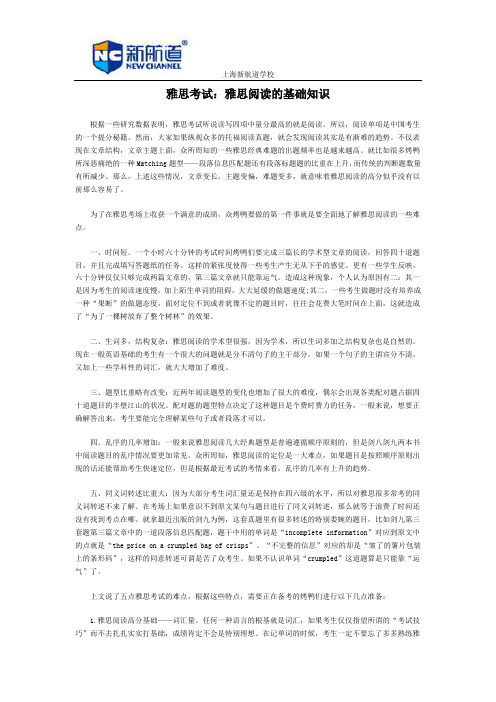
上海新航道学校雅思考试:雅思阅读的基础知识根据一些研究数据表明,雅思考试听说读写四项中量分最高的就是阅读。
所以,阅读单项是中国考生的一个提分秘籍。
然而,大家如果纵观众多的托福阅读真题,就会发现阅读其实是有渐难的趋势。
不仅表现在文章结构,文章主题上面,众所周知的一些雅思经典难题的出题频率也是越来越高。
就比如很多烤鸭所深恶痛绝的一种Matching题型——段落信息匹配题还有段落标题题的比重在上升,而传统的判断题数量有所减少。
那么,上述这些情况,文章变长,主题变偏,难题变多,就意味着雅思阅读的高分似乎没有以前那么容易了。
为了在雅思考场上收获一个满意的成绩,众烤鸭要做的第一件事就是要全面地了解雅思阅读的一些难点。
一、时间短。
一个小时六十分钟的考试时间烤鸭们要完成三篇长的学术型文章的阅读,回答四十道题目,并且完成填写答题纸的任务。
这样的紧张度使得一些考生产生无从下手的感觉。
更有一些学生反映,六十分钟仅仅只够完成两篇文章的,第三篇文章就只能靠运气。
造成这种现象,个人认为原因有二:其一是因为考生的阅读速度慢,加上陌生单词的阻碍,大大延缓的做题速度;其二,一些考生做题时没有培养成一种“果断”的做题态度,面对定位不到或者犹豫不定的题目时,往往会花费大笔时间在上面,这就造成了“为了一棵树放弃了整个树林”的效果。
二、生词多,结构复杂:雅思阅读的学术型很强,因为学术,所以生词多加之结构复杂也是自然的。
现在一般英语基础的考生有一个很大的问题就是分不清句子的主干部分,如果一个句子的主谓宾分不清,又加上一些学科性的词汇,就大大增加了难度。
三、题型比重略有改变:近两年阅读题型的变化也增加了很大的难度,偶尔会出现各类配对题占据四十道题目的半壁江山的状况。
配对题的题型特点决定了这种题目是个费时费力的任务,一般来说,想要正确解答出来,考生要能完全理解某些句子或者段落才可以。
四、乱序的几率增加:一般来说雅思阅读几大经典题型是普遍遵循顺序原则的,但是剑八剑九两本书中阅读题目的乱序情况要更加常见。
雅思g类阅读提升技巧

雅思g类阅读提升技巧咱都知道,雅思 G 类阅读就像一个神秘的大宝藏,里面啥都有,可想要把这些宝藏都挖出来,还真得有点本事。
今天我就跟大伙唠唠我自己摸索出来的提升技巧,这里面可全是我自己掉过的坑、踩过的雷,还有那灵光一闪的瞬间,保证都是实实在在的干货。
我记得有一次我去参加一个社区的读书分享会,那场面,人山人海的。
我本来想着就是去凑个热闹,听听大家都读啥书。
结果到了现场,我就懵了。
主持人让大家分享最近读的一本好书,还要说出书里的一些细节和感悟。
我一听就慌了,为啥呢?因为我读书的时候就走马观花,看个大概,哪能记住那些细节啊。
看着别人说得头头是道,我就只能在旁边干瞪眼。
这就跟雅思 G 类阅读似的,你要是平时阅读习惯不好,只是随便看看,到了考试的时候,那些题目可不会轻易放过你。
那怎么改变这种状况呢?首先,咱得学会精读。
啥叫精读呢?就拿我后来读的一本小说《小王子》来说吧。
我刚开始读的时候,就像以前一样,快速地翻页,心里只想着赶紧把故事读完。
结果读完一遍,除了知道小王子在各个星球上晃悠,其他啥都没记住。
后来我就换了个方法,我慢慢地读,一个字一个字地看。
读到小王子和狐狸相遇的那段,我就停下来,仔细琢磨他们说的话。
狐狸说:“对我来说,你无非是个孩子,和其他成千上万个孩子没有什么区别。
我不需要你,你也不需要我。
对你来说,我无非是只狐狸,和其他成千上万只狐狸没有不同。
但如果你驯化了我,那我们就会彼此需要。
” 我就想啊,这驯化是啥意思呢?我就开始查字典,看注释,还在旁边写了自己的理解。
我发现原来这不仅仅是简单的驯服,还有一种情感上的连接。
这就好比雅思 G 类阅读里那些看似简单的单词,其实背后都有深意,你得深挖才能真正理解文章。
除了精读,泛读也不能少。
我这人平时喜欢看各种八卦杂志,什么明星绯闻啊,时尚潮流啊,我都爱看。
有一次我在看一本时尚杂志的时候,看到一篇关于某个时尚品牌背后故事的文章。
这文章可长了,我本来想随便翻翻就完事儿。
如何提高雅思阅读速度
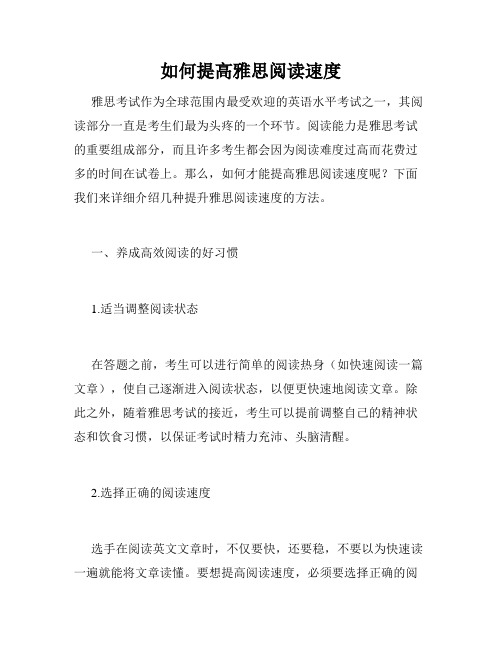
如何提高雅思阅读速度雅思考试作为全球范围内最受欢迎的英语水平考试之一,其阅读部分一直是考生们最为头疼的一个环节。
阅读能力是雅思考试的重要组成部分,而且许多考生都会因为阅读难度过高而花费过多的时间在试卷上。
那么,如何才能提高雅思阅读速度呢?下面我们来详细介绍几种提升雅思阅读速度的方法。
一、养成高效阅读的好习惯1.适当调整阅读状态在答题之前,考生可以进行简单的阅读热身(如快速阅读一篇文章),使自己逐渐进入阅读状态,以便更快速地阅读文章。
除此之外,随着雅思考试的接近,考生可以提前调整自己的精神状态和饮食习惯,以保证考试时精力充沛、头脑清醒。
2.选择正确的阅读速度选手在阅读英文文章时,不仅要快,还要稳,不要以为快速读一遍就能将文章读懂。
要想提高阅读速度,必须要选择正确的阅读速度。
在读题之前,应该对文章进行快速浏览,找准文章的主旨和重点,对于那些重要的信息,可以适当放慢速度进行反复阅读。
3.把握结构关系阅读英语文章不仅要懂得词汇、语法等,还要把握文章的结构关系,如上下文的联系,首尾呼应等等。
在平时练习中,可以使用“画线”等方法来标识出文章的重点句子和关键词,并分析其结构关系,以加深对文章的理解。
4.勤于阅读除了做模拟试卷以外,平时还要有阅读的习惯,可多读英语资料,如英文文章、英文小说等。
随着阅读量的积累,不仅能够提高阅读能力,还能深化对英语的理解和运用,更有利于提高阅读速度。
二、灵活应用答题技巧1.对文章形式进行分析在阅读文章时,要先盘点文体、文种、文体特征、结构等几个方面。
试图尽量在阅读文章之前理顺这些,方便考生快速“上手”。
2.预估答案在对题目进行考虑之前,考生可以先根据题干对问题进行预估,并尝试用自己的语言模拟出答案,以便更好地理解文章内容。
3.掌握答题顺序在进行阅读考试时,考生要根据试卷内容灵活应对,先做易做的题目,再去应对难度更大的细节和理解型题目。
这样可以为自己在时间上留出更多的余地。
4.考虑词汇和句法有些阅读题目要求考生对特定的词汇和句型进行理解。
阅读速度与准确性的平衡提高阅读效率的关键要素
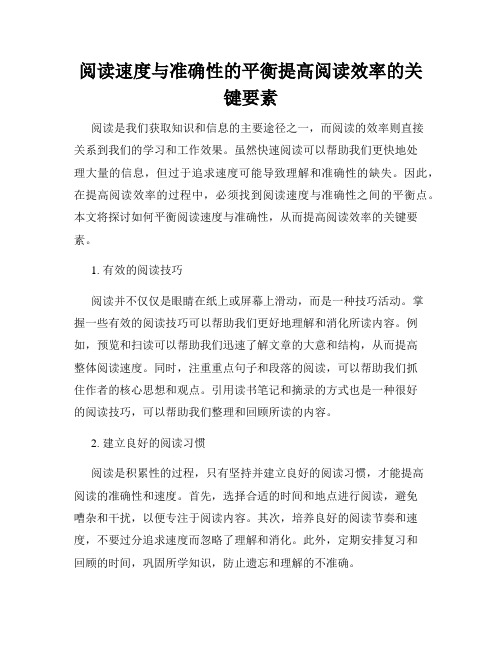
阅读速度与准确性的平衡提高阅读效率的关键要素阅读是我们获取知识和信息的主要途径之一,而阅读的效率则直接关系到我们的学习和工作效果。
虽然快速阅读可以帮助我们更快地处理大量的信息,但过于追求速度可能导致理解和准确性的缺失。
因此,在提高阅读效率的过程中,必须找到阅读速度与准确性之间的平衡点。
本文将探讨如何平衡阅读速度与准确性,从而提高阅读效率的关键要素。
1. 有效的阅读技巧阅读并不仅仅是眼睛在纸上或屏幕上滑动,而是一种技巧活动。
掌握一些有效的阅读技巧可以帮助我们更好地理解和消化所读内容。
例如,预览和扫读可以帮助我们迅速了解文章的大意和结构,从而提高整体阅读速度。
同时,注重重点句子和段落的阅读,可以帮助我们抓住作者的核心思想和观点。
引用读书笔记和摘录的方式也是一种很好的阅读技巧,可以帮助我们整理和回顾所读的内容。
2. 建立良好的阅读习惯阅读是积累性的过程,只有坚持并建立良好的阅读习惯,才能提高阅读的准确性和速度。
首先,选择合适的时间和地点进行阅读,避免嘈杂和干扰,以便专注于阅读内容。
其次,培养良好的阅读节奏和速度,不要过分追求速度而忽略了理解和消化。
此外,定期安排复习和回顾的时间,巩固所学知识,防止遗忘和理解的不准确。
3. 提高词汇量和语言理解能力词汇量和语言理解能力是提高阅读准确性和速度的重要基础。
通过增加词汇量和提升语言理解能力,我们能够更好地理解和解读所读的文章。
可以通过阅读更多各种类型的书籍、文章和报纸来扩大词汇量,积累更多的词汇和短语。
同时,可以通过参加词汇和语言理解的培训课程来提高自己的语言能力,如参加托福、雅思或其他语言考试的培训。
4. 提高注意力集中能力注意力是阅读的重要组成部分,而提高注意力的集中能力可以帮助我们更好地专注于所读的内容,提高阅读的准确性和速度。
可以通过一些训练和练习来提高自己的注意力集中能力,如冥想和集中力训练等。
此外,保持良好的精神状态、合理的休息和饮食习惯也有助于提高注意力的集中能力。
- 1、下载文档前请自行甄别文档内容的完整性,平台不提供额外的编辑、内容补充、找答案等附加服务。
- 2、"仅部分预览"的文档,不可在线预览部分如存在完整性等问题,可反馈申请退款(可完整预览的文档不适用该条件!)。
- 3、如文档侵犯您的权益,请联系客服反馈,我们会尽快为您处理(人工客服工作时间:9:00-18:30)。
雅思阅读速度提高的四个基本
雅思阅读考试文章长,单词多而且时间短,所以大家在备考雅思阅读考试的时候,一个重要的内容就是要提高雅思阅读速度。
下面前程百利出国考试为大家整理了雅思阅读速度提高四个最基本的方面,可以从根本上提高雅思阅读速度,供大家在备考的时候进行参考。
其一:单词量
从考试的实用度来说,单词可以分为三种:
■不需认识的:例如剑桥五上一篇讲塑料的文章中的asbestos(石棉)、formaldehyde (甲醛)、phenol(苯酚)等;
■需认识但是无需熟练掌握的:阅读不是写作,它是门输入型的考试,这类单词只需在考试中能回忆出其大致意思即可,例如pyramid(金字塔)、sphinx(狮身人面像);
■需熟练掌握类:这是最重要的一类,需熟练掌握它的用法以及同义词(这组词大部分都包含在四、六级词汇中)。
百利天下教育考试专家建议:背单词不妨用些巧妙的办法,充分发挥想象力,就能把这个枯燥的任务变得充满乐趣。
比如Ivy:长青藤。
把IV看作罗马数字四,把Y想象成一棵树,连起来就是一年四季都长青的植物,推出长青藤之意;再如avarice:贪婪,rice的意思大家都知道,我们把V移到两个a的下面,很像一个人的脸。
我们就把这个词想象成一个人很想吃饭,进而联想到贪婪的意思。
其二:一词多义(背单词的升级版)
这种情况较第一种情况更郁闷一些。
好好一句话,单词都认识,偏偏就是看不懂意思。
其实,如果我们知道这是由一词多义现象造成的话,这种情况也就能自动归到第一种,因为这个一词多义的单词到了这句话中,对我们而言就是一个生词。
例如absence这个单词常译为“缺席”,但在文章中很多时候都表示“没有”,这两个意思有很大程度的关联性。
百利天下教育介绍settlement,很多人都知道是“定居”的意思,在很多雅思专业型文章里却译为“下沉”。
于是很多学生就非常不解了。
其实不妨换位思考一下,我们的母语汉语有无一词多义呢?显然太多了。
比如贼这个字指“小偷”,是名词;到了某些特殊的语境中却可以表示“非常”,变成了形容词。
不但连意思变了,连词性也转了。
那么,推己及人,英语也是一样的道理。
大家背单词时一定要特意留心一个单词的词性,从而逐渐消除由于一词多义而造成的阅读障碍。
其三:语法
说到语法,中国人的英语语法还不够好么?绝对够好!但我们习得的语法太过学术化,以至于我们对西方惯用方式反而陌生。
举个最简单的例子:Yet大家都认识,但雅思考试有一句常见的话:The scientists have yet to determine the……很多考生并没看出这是个否定句而出错,这就十分可惜了。
再如:Children do not end up on the street due to a single cause,but to a combination of factors。
很简单的一句话,对大部分考生来说基本不存在生词障碍,但是这句话中有两种必需掌握的语法:否定前置,Not否定的是due to而不是end up以及省略,but 和to 之间省略了一个to。
特别是看出否定前置尤为重要,不然整句的意思就面目全非了。
其四:做题方法
首先,了解出题者思路是一个很聪明的做题方法。
比如important和necessary,我们中国学生有时思路非常缜密,认为重要的不一定是必要的,但是必要的就一定是重要的。
这绝对是一个很完善的逻辑,但遗憾的是,西方人的思路非常简单,在他们眼里,这两个单词首先不矛盾,其次他们都指向需要、重要,那就没必要分那么细,于是这两个词是同义词。
再有,阅读的一点难点在于迅速找出题目所对应的原文。
这就须知道相关词的概念,即两个词未必意思一样但之间有关系。
例如 expensive,大部分学生立刻会想到costly,not cheap,这里给大家一个单词Rolls Royce(劳斯莱斯),这两个单词在雅思阅读中就属于一种很巧妙的相关词,因为后者具有昂贵这个特点。
再如bird有什么相关词呢?很多学生要去想背过的鸟的名字了,但雅思考试中却曾拿 Nest(雀巢)来与bird作为相关词来与之对应。
这样的例子数不胜数,只有当我们收集到足够多的例子,才能从本质上提高阅读速度。
以上就是关于提高雅思阅读速度的四个基本方面,非常详细,其中对于详读和略读的方法应用是考生在备考中最应该掌握的,这两种方法在考场中的作用也是最明显的,大家可以在备考自己的雅思阅读考试的时候对此加以适当的练习和应用。
